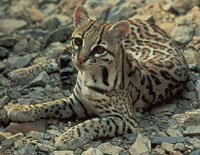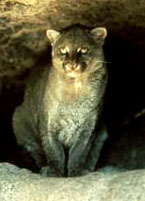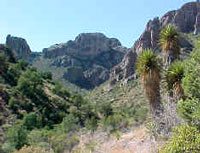The Texas-Mexico border has long been a setting for political skirmishes, a conflict zone where figures hide in shadows hoping to find a loophole in the paramilitary operations that attend the Rio Grande, the river that separates the U.S. from its southern neighbor.

This ocelot doesn’t have nine lives.
Photo: U.S. Department of Fish and Wildlife.
When the U.S. Immigration and Naturalization Service (INS) decided in the late ’90s to beef up its border operations in the lower Rio Grande Valley, it followed that it would become harder to hide out in the brushy habitat stretching between the small towns of south Texas. But the INS didn’t realize that by increasing patrols, clearing ground cover, erecting fences, paving roads, and shining bright lights along river basins, it would not just put pressure on illegal immigrants and smugglers but also diminish the chances of survival for a pair of endangered wildcats, the ocelot and jaguarundi.
These cats persist in only a few areas of the American West. At last count, there were fewer than 100 ocelots in Texas, most making their homes in the various federal wildlife refuges that dot the Rio Grande Valley, which Johnny French of the U.S. Fish and Wildlife Service (USFWS) calls “our string-of-pearls refuge,” because, unlike most national preserves and parks, the properties are not part of a complete whole. The housecat-sized jaguarundi may be even more rare than the ocelot: The only confirmed jaguarundi sightings in Texas since the last census nearly a decade ago have been roadkill.

Blinded by the light? A jaguarundi.
Both of these sensitive kitties prefer to roam in thick native grasses that harbor insects, birds, and rodents, the kind of ecosystem that is fast disappearing from Texas and elsewhere thanks to increased development and the conversion of grasslands into cattle ranches. “We’re losing habitat all over the place,” says French. “It’s a private lands issue, and we just don’t have a lot of control over that, but we can preserve more habitat for the cats with the help of the border patrol. It’s not going to be easy, but I’m sure we can find a way to work this out.”
Complicating the already tense situation, French notes, are human rights questions and issues of economic disparity that threaten to dwarf ecological concerns in the region.
Border, Border in the Court
Last year, environmentalists filed a lawsuit accusing the INS of initiating Operation Rio Grande without adequate public comment or environmental review. According to Defenders of Wildlife, the Sierra Club, and the Frontera chapter of the Audubon Society, the law enforcement agency was negligent when it started placing lights along the border, and it had not adequately consulted with fellow federal agencies when it came to the Endangered Species Act.
Defending the INS, assistant border patrol chief Rey Garza says that the environmentalists tripped up his agency on a technicality. The agency’s main failure, he says, was to not make its plans available to the public as required under the National Environmental Policy Act, but he maintains that for three years, the INS had regular consultations with the USFWS over Operation Rio Grande.

Prime kitty habitat along the Rio Grande.
Under the terms of a settlement reached in September, the USFWS and the EPA will be involved in a formal review of Operation Rio Grande and will consult endangered species statutes with regard to the ocelot and jaguarundi. A full environmental impact statement (EIS) will be completed by next summer, and the public will get two months to comment. Until the EIS is completed, the INS will close 11 roads along the wildlife corridor, limit mowing in the Rio Grande floodplain, and refrain from installing new lights, fences, boat ramps, and roads. As the INS looks at future projects along the U.S.-Mexico border, this case may provide a model for what’s acceptable.
The settlement pleases Mary Lou Campbell, a Texas Audubon member, who has been on the ground working with the border patrol to make the efforts of the INS more environmentally friendly. “Sometimes it takes public action to get the federal agencies to follow the law, but we have to be optimistic,” says Campbell. “This is a region of enormous biodiversity. It’s a meeting place between tropical and subtropical ecosystems, and serves as a last frontier for many of these species.”
Garza of the INS says he believes national security and environmental policy can be compatible in the long run. “Of course we believe national security is more important,” he says, “but there was quite a bit of controversy and I think we’ve shown that we can work together and turned this into a positive thing.”


